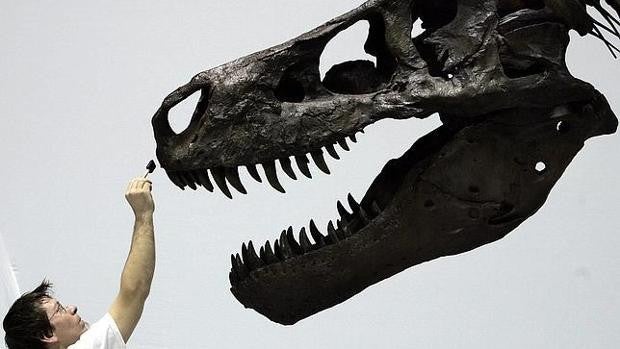 The fearsome tyrannosaurs, those that ruled the Northern Hemisphere during the Late Cretaceous period (between 100 and 66 million years ago), may not fit the profile of solitary predators, as has been thought until now. There is a hypothesis that they were actually social carnivores similar to wolves. This is not a new theory: 20 years ago, the bodies of 12 tyrannosaurs were found in a site in Alberta, Canada, which, for the first time, made the scientific community rethink the image of these giant "killing machines." Did they perhaps have the intellectual capacity to organize themselves into something more complex than what is observed in modern crocodiles?
The fearsome tyrannosaurs, those that ruled the Northern Hemisphere during the Late Cretaceous period (between 100 and 66 million years ago), may not fit the profile of solitary predators, as has been thought until now. There is a hypothesis that they were actually social carnivores similar to wolves. This is not a new theory: 20 years ago, the bodies of 12 tyrannosaurs were found in a site in Alberta, Canada, which, for the first time, made the scientific community rethink the image of these giant "killing machines." Did they perhaps have the intellectual capacity to organize themselves into something more complex than what is observed in modern crocodiles?
However, because the Canadian site appeared to be an isolated case, skeptics claimed it represented unusual circumstances that did not reflect normal tyrannosaur behavior. The discovery of a second tyrannosaur mass-kill site in Montana again raised the possibility of social tyrannosaurs, but this site was not widely accepted by the scientific community as evidence of social behavior. Now, the discovery of another fossil bone site within Grand Staircase-Escalante National Monument in Utah, USA, containing the remains of several dinosaurs of the same species may provide a boost to the social tyrannosaur theory. The findings have just been published in the journal Peerj.
"This supports our hypothesis that these tyrannosaurs died in this location and were fossilized together; they all died in the same place, and this information is key to our interpretation that the animals were likely gregarious in their behavior," says Celina Suarez, associate professor of geosciences at the University of Arkansas and one of the authors of the study. This means they weren't solitary hunters, but rather may have formed a kind of "pack" like wolves.
One of the fossils found in the Rainbow and Unicorn Quarry
–
US Bureau of Land Management
The Rainbow Quarry and the Unicorns
The discovery of this group of tyrannosaurs took place in the quaintly named 'Rainbow and Unicorn Quarry,' a unique site from which researchers claim many insights can be drawn about the behavior of these extinct animals. "Traditional excavation techniques, complemented by analysis of rare earth elements, stable isotopes, and carbon concentrations, convincingly show a synchronous death event at this site of four or five tyrannosaurs. This group undoubtedly died together, adding to a growing body of evidence that tyrannosaurs were capable of interacting as gregarious herds," says Philip Currie, a tyrannosaur expert and one of the study's authors.
In 2014, BLM paleontologist Alan Titus discovered the Rainbow and Unicorn Quarry site, the first location where multiple tyrannosaur skeletons have been found in the southern United States. Researchers conducted a series of tests and analyses of remains from the original site—now preserved as small rock fragments and fossils in this “dinosaur graveyard”—and sandbar deposits from the ancient river. “We immediately realized this site could be used to test the idea of a social tyrannosaur,” Titus said. “Unfortunately, the ancient history of the site is complicated,” Titus said. “With bones that appear to have been unearthed and reburied by river action, the original context in which they were found has been destroyed. However, not all is lost.” As details of the site’s history emerged, the research team concluded that the tyrannosaurs died together during a seasonal flooding event that deposited their carcasses in the lake. Then, a river made its way between the bones, through the bed in which they rested.
Using stable carbon and oxygen isotope analysis and rare earth element concentrations within the bones and rock, Suárez and his then-PhD student, Daigo Yamamura, were able to find a chemical fingerprint of the site. Based on the geochemical work, they were able to conclusively determine that the remains fossilized in the same environment and were not the result of an assemblage of fossils washed up from different areas. “None of the physical evidence conclusively suggested that these organisms fossilized together, so we turned to geochemistry to see if that might help us. The similarity of the rare earth element patterns is a good indicator that these organisms died and fossilized together,” Suárez said.
Other species found
Excavation of the quarry has been ongoing since its discovery in 2014, and due to the size of the site and the volume of bones found there, excavation will likely continue in the future. In addition to tyrannosaurs, seven species of turtles, multiple species of fish and rays, two other types of dinosaurs, and a nearly complete skeleton of a crocodile have also been found at the site.
Deinosuchus
juvenile, although all these specimens do not appear to have died with the group of tyrannosaurs.
"This evidence adds to all the previous evidence indicating that tyrannosaurs were large, complex predators capable of social behaviors common to many of their living relatives, such as birds," says Joe Sertich, curator of dinosaurs at the Denver Museum and a collaborator on the project. "This discovery should be the turning point in reconsidering how these top carnivores behaved and hunted throughout the Northern Hemisphere during the Cretaceous."
